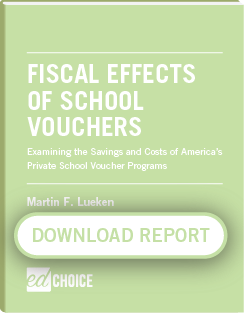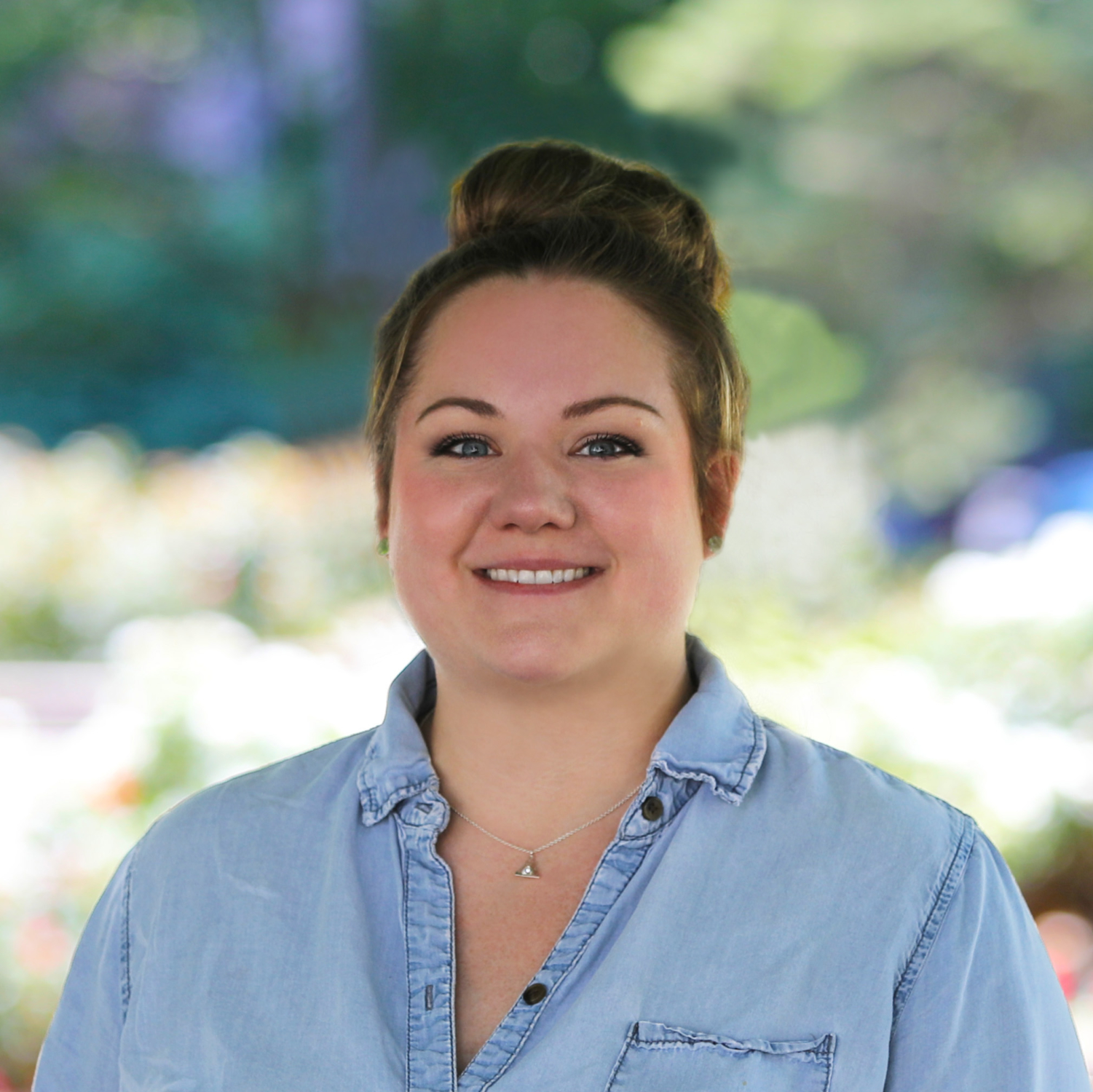Study Finds America’s School Voucher Programs Have Saved Billions
In our latest study, EdChoice’s Director of Fiscal Policy and Analysis Marty Lueken examined the fiscal impact of voucher programs in Florida, Georgia, Indiana, Louisiana, Mississippi, Ohio, Oklahoma, Utah, Wisconsin and the District of Columbia—from their inception through FY 2015—to determine whether they generated costs or savings for state and local taxpayers.
Find out what we learned using the resources below.
Our Podcast Transcribed
Drew Catt: Hello, and welcome to another episode of EdChoice Chats. I’m Drew Catt, and I’m here today with Marty Lueken to discuss his latest work, a report called “Fiscal Effects of School Vouchers.” Thanks for joining us today, Marty.
Marty Lueken: It’s great to be here today with you, Drew.
Drew Catt: Awesome. Well, let’s begin at the most logical place, which is, what inspired you to work on this piece? What did you set out to discover?
Marty Lueken: The motivation for this piece is that the most common criticism we face from the critics of prep school choice is that the school choice program somehow siphoned or drained resources from public schools whenever student choose to leave district schools to attend private schools via those programs.
So, given those concerns, policymakers, other stakeholders, tax payers, usually want to know the fiscal effects of these programs on their state and local budgets. So while it’s true that the funding the district receives goes down whenever a student leaves for any reason, costs also go down. However, the skeptics tend to focus on just one part of the equation, the cost, without acknowledging or accounting for the other side of the equation, the potential savings these programs generate.
So, that’s basically what we set out to do with this report.
Drew Catt: Awesome. How many programs did you look at? And do these fiscal effects vary by state?
Marty Lueken: So, we looked at 16 programs in nine states plus the District of Columbia. This is actually an update of a report that my predecessor, Jeff Spalding did called “The School Voucher Audit,” where he looked at the fiscal effects through 2014. Since then, four years of data have become available, so that we can look at an additional six programs since then. The states we look at include Florida, Georgia, Indiana, Louisiana, Mississippi, Ohio, Oklahoma, Utah, and Wisconsin. We do see that the fiscal effects do vary. That’s because, simply, the programs, the bills are written differently. The policies are written differently, how the vouchers are funded are different. Plus the cost structures for the schools across districts also differ as well.
Drew Catt: So before we delve deeper into this topic, our listeners might need a little bit of a rundown. How do you actually go about calculating the costs or savings associated with these programs?
Marty Lueken: There are two key factors that any fiscal analysis of a prep school choice program really needs to account for. One are switchers. Switchers are students who participate in these programs who would enroll in a district school or public school without the financial assistance from the voucher program, or the school choice program. And then a second key factor are the variable cost savings. When I talk about variable costs, it refers to fixed and variable costs. So fixed costs are things that include utilities, debt service, maintenance, things like that. These are the costs that can’t be reduced in the short run. Variable costs, on the other hand, are things that you can reduce in the short run, such as supplies or personnel, if enough students leave to consolidate classrooms. You know, things like that.
So we account for those two factors, and what determines whether a program generates a net benefit or a net cost for state level taxpayers will essentially be the fiscal alignment. So as long as, when a student leaves a district to participate in a voucher program, if the voucher is less than the variable cost savings that a district would experience, then that program is generating a net benefit for taxpayers.
Drew Catt: Okay, so if the cost is less than the savings, then there’s overall savings. Okay, sounds pretty straightforward, but I know that there’s a lot more that goes into it. So what kind of savings did you find?
Marty Lueken: Overall, we found that the 16 programs analyzed in the report generated a cumulative net savings to state and local budgets worth about $3.2 billion from when those programs were launched through fiscal year 2015. Those savings represent about $3400 per voucher recipient. In the last year of the analysis alone, in 2015, all the programs that year generated over $400 million in cumulative savings, or about a little over $3000 per voucher.
Drew Catt: So that’s $400 million just in 2015.
Marty Lueken: Right.
Drew Catt: Wow, that’s phenomenal.
Well, we still want to leave our listeners plenty of reason to read your report, so I won’t ask you to reveal everything you’ve outlined in it, but I’m curious. What kinds of things could be done with these savings? And can only certain districts actualize the savings, or are the savings only at the state level?
Marty Lueken: The savings occur at both levels, state and local. To isolate the impact on the state’s general fund or the state’s budget alone, you really would have to dig into and use the state’s funding formula. Which, these funding formulas are incredibly complex and they differ in so many different ways across states. So for an analysis like this that looks at programs nationwide, that’s just time-prohibitive to do that. But at least the approach that we take, we’re able to look at the impact on state and local taxpayers.
Drew Catt: So, governments, they face choices with what to do with these savings. If they wanted, they could lower taxes, they could build reserves, so-called rainy day funds. They could, if they wanted, redirect those funds to other areas or other public services like health care or law enforcement. Or they could choose to, if they have an issue with debt, they could choose to pay down debt. So they do have options with what to do. Now, if they don’t do anything, if they don’t actively direct these savings, then what happens is that, implicitly, these funds are just being reinvested into the districts. And so, what happens then is that the districts end up with more resources for fewer students that they have to educate. And the byproduct of that is that the resource per pupil will go up.
So yeah, hypothetically, that means that teachers’ salaries could go up. That kind of sounds like a no-brainer, but why do you think some of these actions and some of these ways of shifting around some of these dollars saved haven’t fully happened yet?
Marty Lueken: Well, I think we just don’t know what happens. There are a couple states, to their credit, that actively estimate and report the fiscal impacts of their programs. Iowa and Florida are examples. Every year or so they will estimate and report what the fiscal impact of their school choice programs have been on the state’s general fund. With that said, we don’t know what happens to those savings. So I think what’s likely is happening is that nothing is being actively done, and so, in effect, we’re seeing these savings being just reinvested into public schools. And that may be one contributing factor to the rise of per-pupil funding that we see over time.
Drew Catt: A lot of folks might disagree that these programs actually save money, even when presented with the facts outlined in your report. And they’ll also claim that participating students would attend private school anyway, that switchers may not actually exist. How would you respond to those critics?
Marty Lueken: Well, first, how we’ve designed school choice programs to date, they tend to be targeted. They’re targeted at disadvantaged populations. Voucher programs tend to be focused, usually at low-income students or students with special needs or disabilities. And those are populations that tend to enroll in public schools in the first place.
Also, a lot of programs have prior enrollment requirements, so in order to participate in the programs, usually you have to be enrolled in the public school in the year before you use the voucher. So for those reasons, the switcher rate is going to be pretty high, and so that’s why we see these savings. But at the end of the day, it’s impossible to know where a student would be enrolled, whether in public or private school without the program. Life circumstances change, so one year, a student can have parents who are both working, they have a steady income and they’re able to afford a private school. But one parent might lose their job, so then they can no longer afford tuition, and so their child would be enrolled in public school. Or vice versa. A parent could get a promotion, and so then suddenly they can afford tuition, and they may decide that another school better fits their needs.
But my overall point though, is it really is impossible to know this. But the analysis that I conducted, I did make every attempt to account for switchers and find out which proportion of the participants were switchers versus non-switchers and the way that I did that was I contacted state education departments and asked for information on where students in the voucher programs were enrolled prior to participating in the program.
Drew Catt: Yeah, and I remember from my own digging a little bit, that there are some states that believe that every single kindergartner entering a program would have attended private school anyways, which is just fascinating to me.
Marty Lueken: Right.
Drew Catt: That’s a really interesting assumption to make.
Marty Lueken: Right.
Drew Catt: Well, excellent, Marty. Is there anything we haven’t covered that you think our listeners should know about fiscal effects of school vouchers?
Marty Lueken: You know, I think it’s great that these programs are generating savings, but I also want to make clear that we’re not advocating that school choice programs should be designed solely to pursue that result. Rather, I think that it’s important that policy makers consider a system where all dollars follow the kids. Because the way that the programs are designed now, funding is inequitable. Even before choice programs were introduced, we have problems with funding equitability across districts, just within the public school system. So now we have another system that’s creating more inequity.
I think that, at the end of the day, we should have a system that invites entrepreneurship and invites education providers to be incentivized to enter and try to meet the variegated demands for all families and all children.
Drew Catt: Yeah, because it’s not necessarily one versus another, but just equal access to all.
Marty Lueken: Exactly.
Drew Catt: All right, well, thank you so much for joining us, Marty. And props go out to our listeners for taking the time to learn a little more about the savings associated with school vouchers.
To stay updated on the latest school choice research, legislative news, and more, please remember to subscribe to our EdChoice Chats podcast. Our team is always creating new school choice resources. If you want to be notified when those become available, you can sign up to receive our emails on the web at edchoice.org.
If social media is more your thing, follow us on Twitter, Instagram, and even Facebook at EdChoice. That’s it for our shameless self-promotion. Thanks again for listening, and until next time, take care.





